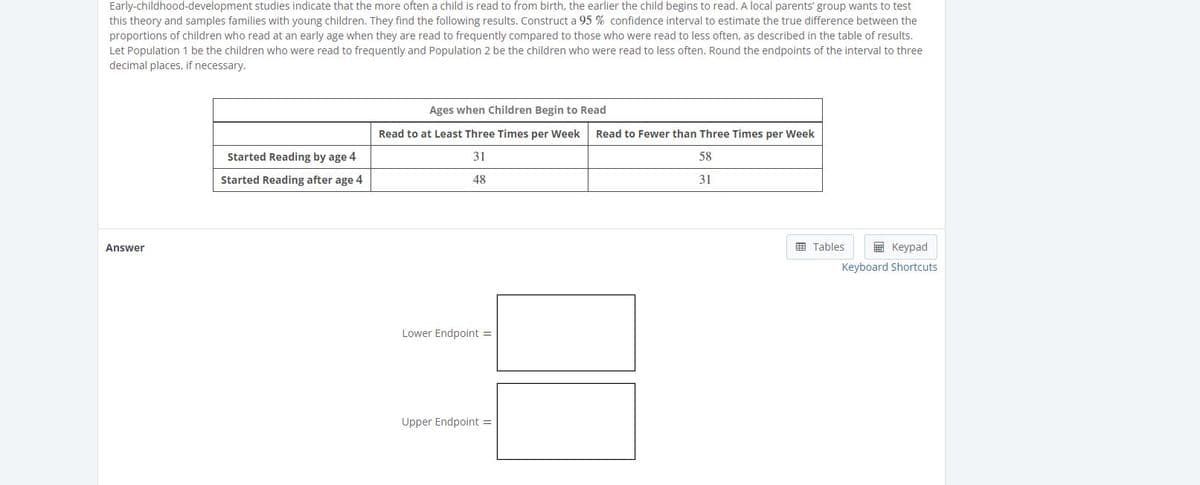this theory and samples families with young children. They find the following results. Construct a 95 % confidence interval to estimate the true difference between the proportions of children who read at an early age when they are read to frequently compared to those who were read to less often, as described in the table of results. Let Population 1 be the children who were read to frequently and Population 2 be the children who were read to less often. Round the endpoints of the interval to three decimal places, if necessary. Ages when Children Begin to Read Read to at Least Three Times per Week Read to Fewer than Three Times per Week Started Reading by age 4 31 58 Started Reading after age 4 48 31 Answer I Tables Кеурad Keyboard Shortcuts Lower Endpoint = Upper Endpoint =
this theory and samples families with young children. They find the following results. Construct a 95 % confidence interval to estimate the true difference between the proportions of children who read at an early age when they are read to frequently compared to those who were read to less often, as described in the table of results. Let Population 1 be the children who were read to frequently and Population 2 be the children who were read to less often. Round the endpoints of the interval to three decimal places, if necessary. Ages when Children Begin to Read Read to at Least Three Times per Week Read to Fewer than Three Times per Week Started Reading by age 4 31 58 Started Reading after age 4 48 31 Answer I Tables Кеурad Keyboard Shortcuts Lower Endpoint = Upper Endpoint =
Glencoe Algebra 1, Student Edition, 9780079039897, 0079039898, 2018
18th Edition
ISBN:9780079039897
Author:Carter
Publisher:Carter
Chapter4: Equations Of Linear Functions
Section: Chapter Questions
Problem 8SGR
Related questions
Question

Transcribed Image Text:Early-childhood-development studies indicate that the more often a child is read to from birth, the earlier the child begins to read. A local parents' group wants to test
this theory and samples families with young children. They find the following results. Construct a 95 % confidence interval to estimate the true difference between the
proportions of children who read at an early age when they are read to frequently compared to those who were read to less often, as described in the table of results.
Let Population 1 be the children who were read to frequently and Population 2 be the children who were read to less often. Round the endpoints of the interval to three
decimal places, if necessary.
Ages when Children Begin to Read
Read to at Least Three Times per Week
Read to Fewer than Three Times per Week
Started Reading by age 4
31
58
Started Reading after age 4
48
31
Answer
E Tables
E Keypad
Keyboard Shortcuts
Lower Endpoint =
Upper Endpoint =
Expert Solution
This question has been solved!
Explore an expertly crafted, step-by-step solution for a thorough understanding of key concepts.
This is a popular solution!
Trending now
This is a popular solution!
Step by step
Solved in 2 steps with 2 images

Recommended textbooks for you

Glencoe Algebra 1, Student Edition, 9780079039897…
Algebra
ISBN:
9780079039897
Author:
Carter
Publisher:
McGraw Hill

College Algebra (MindTap Course List)
Algebra
ISBN:
9781305652231
Author:
R. David Gustafson, Jeff Hughes
Publisher:
Cengage Learning

Glencoe Algebra 1, Student Edition, 9780079039897…
Algebra
ISBN:
9780079039897
Author:
Carter
Publisher:
McGraw Hill

College Algebra (MindTap Course List)
Algebra
ISBN:
9781305652231
Author:
R. David Gustafson, Jeff Hughes
Publisher:
Cengage Learning